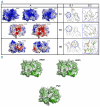Stereotyped patterns of B-cell receptor in splenic marginal zone lymphoma
- PMID: 20511668
- PMCID: PMC2948108
- DOI: 10.3324/haematol.2010.025437
Stereotyped patterns of B-cell receptor in splenic marginal zone lymphoma
Abstract
Antigen stimulation may be important for splenic marginal zone lymphoma pathogenesis. To address this hypothesis, the occurrence of stereotyped B-cell receptors was investigated in 133 SMZL (26 HCV+) compared with 4,414 HCDR3 sequences from public databases. Sixteen SMZL (12%) showed stereotyped BCR; 7 of 86 (8%) SMZL sequences retrieved from public databases also belonged to stereotyped HCDR3 subsets. Three categories of subsets were identified: i) "SMZL-specific subsets" (n=5), composed only of 12 SMZL (9 HCV-from our series); ii) "Non-Hodgkin's lymphoma-like subsets" (n=5), comprising 5 SMZL (4 from our series) clustering with other indolent lymphomas; iii) "CLL-like subsets" (n=6), comprising 6 SMZL (3 from our series) that belonged to known CLL subsets (n=4) or clustered with public CLL sequences. Immunoglobulin 3D modeling of 3 subsets revealed similarities in antigen binding regions not limited to HCDR3. Overall, data suggest that the pathogenesis of splenic marginal zone lymphoma may involve also HCV-unrelated epitopes or an antigenic trigger common to other indolent lymphomas.
Figures

References
-
- Swerdlow SHCE, Harris NL, Jaffe ES, Pileri SA, Stein H, Thiele J, Vardiman JW. WHO Classification of Tumours of Haematopoietic and Lymphoid Tissues. Lyon: IARC Press; 2008.
-
- Matutes E, Oscier D, Montalban C, Berger F, Callet-Bauchu E, Dogan A, et al. Splenic marginal zone lymphoma proposals for a revision of diagnostic, staging and therapeutic criteria. Leukemia. 2008;22(3):487–95. - PubMed
-
- Arcaini L, Lazzarino M, Colombo N, Burcheri S, Boveri E, Paulli M, et al. Splenic marginal zone lymphoma: a prognostic model for clinical use. Blood. 2006;107(12):4643–9. - PubMed
-
- Saadoun D, Suarez F, Lefrere F, Valensi F, Mariette X, Aouba A, et al. Splenic lymphoma with villous lymphocytes, associated with type II cryoglobulinemia and HCV infection: a new entity? Blood. 2005;105(1):74–6. - PubMed

